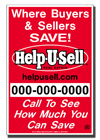Traditional real estate brokers don’t get us. They don’t understand how in the world Help-U-Sell brokers can afford to be in business. After all, they charge a seller about 3 times what we charge and even at that it’s near impossible to turn a profit. Obviously we must be cutting corners, cutting service, skimping on, well . . . everything.
The reason they don’t get it is that they look at the Help-U- Sell consumer offering through their traditional broker eyes. They see our low set fee and then immediately picture what would be left after splitting with an agent: next to nothing! Of course that would make no sense at all; therefore, Help-U-Sell must make no sense at all, right? Wrong.
The error here is in assuming we have the same business model they have, that we conduct business the same way they do. Nothing could be further from the truth.
The first thing we do in a Help-U-Sell office is put the broker firmly in charge. He or she takes responsibility for creating an effective marketing plan and for generating all leads into the office. He or she also takes all listings for the company– even if, sometimes a licensed assistant takes them.
So there is no splitting of the listing fee, no sharing of it on a 70/30 basis with an agent. The Listing Fee flows intact, directly to the paying of expenses and ultimately to the bottom line.
‘How can you do that!’ wails the traditional broker. ‘My agents work very hard on their listings! They run ads and hold open houses and follow-up after showings! If nobody’s responsible for that, it won’t get done . . . and service will suck!’
Truth is: we do everything they do in servicing/marketing that listing, and we do it better. First, our marketing is a pre-meditated, carefully tracked system. When we take a listing we don’t suddenly create a whole customized marketing plan for that property. We have a powerful marketing program for all of our listings already running. We just plug the new listing in. (By the way – that customized marketing plan created just for that one listing is mostly smoke and mirrors designed to pacify the seller and create the illusion of activity until the yard sign or the MLS produce a sale).
Then, instead of asking our agents to do some of the less skilled activities associated with selling a home – things like holding open houses, showing people through and keeping the flyer box full – we ask our sellers to take that on. Most agree and, with a little coaching, do an excellent job. The reason they do it is that seller participation creates the greatest opportunity for maximum savings. ‘You mean, if I find my own buyer through an open house or some other method, all I pay is $3,950?’ they say, ‘But if I don’t do that and you bring the buyer I’ll pay $7,900? Sure! I’ll hold a few open houses!’
So, Help-U-Sell offices are offices without agents, right? Wrong.
We love agents and good ones love us. In a Help-U-Sell office, the agent has a focused and manageable job description: they take the buyer leads the broker creates through his marketing and listing activity and converts them into transactions. Period. They don’t prospect, don’t call FSBOs, don’t knock doors, don’t chase around after listings. They simply show up for work, take the buyers created by our marketing and catalogued in the Buyer Pool book, and pick one or more to work.
Sometimes they sell office listings and sometimes they sell homes on the MLS. Either way, they are paid very well for the job that is done, are as busy as they want to be; and without the burden of all those other jobs the traditional agent must do, are in a great position to provide excellent customer service.
So far, this discussion has touched on all five of the Pillars of Help-U-Sell:
- Low Set Fee
- Menu of Services
- Seller Participation
- Targetd Marketing
- Broker Control
Now, let’s take a look at the numbers.
Let’s consider a $200,000 house in a $200,000 market. (Of course, all commissions, whether set fee or percentage are negotiable.) Let’s assume the traditional broker is charging, say, 6%. The Help-U-Sell broker charges $3,950 and has a showing fee of $3,950 (both are set fees; what a concept!)
First, the Seller’s perspective:
Traditional Broker cost: $12,000 no matter where the buyer comes from.
Help-U-Sell:
- Find your own buyer: $3,950, a savings of $8,050!
- HUS brings the buyer: $7,900, a savings of $4,100
- An MLS broker brings the buyer: $3,950 + 3% to the selling broker, a total of $9,950 and a savings of $2,050
Help-U-Sell wins every time.
Now from the broker’s perspective:
The traditional broker will receive $6,000 on the listing side of the commission. He will split that with an agent, probably on a 70% split (that’s NAR’s most recent average) leaving $1,800 to pay the bills and create a profit. Good luck.
The Help-U-Sell Broker receives $3,950 on the listing side no matter how the house sells. There is no agent to pay, so he has $3,950 to pay the bills and make a profit: $2,150 MORE than the traditional broker.
And finally from the Agent’s perspective:
The agent on a 70% split will make $4,200 on the sale of the traditional listing. If a Help-U-Sell buyer agent sells the same listing, he’ll receive about a thousand dollars less because the commission splits are lower. The difference is, the Help-U-Sell agent’s buyer was handed to him. He is not pushed to go out and create business. All he does is take the lead and convert it to a sale, and then go back and get another. The Help-U-Sell agent will probably close twice the number of sides he or she would close in a traditional office and his or her income will be considerably greater.
The traditional agent will make the same $4,200 when he or she sells the Help-U-Sell listing because we allot 3% to the outside selling company (in this example).
If the Help-U-Sell agent sells one of the office listings, he or she is going to receive $3,950 – because in these situations the full Help-U-Sell showing fee is given to the agent. The broker makes the same thing he’d have made no matter how the property was sold: $3,950. The Help-U-Sell agent makes more on the Help-U-Sell listing than on a similarly priced property listed with a competitor, so there is an incentive to sell in-house.
To summarize, with Help-U-Sell:
- The seller almost always saves, and can save significantly
- The broker has a solid flow of listings into the office because of the set fee offer and more revenue flows to expenses and the bottom line than his traditional counterparts.
- The broker also has a strong flow of buyer leads produced by the large number of listings.
- The agent has a streamlined job description and a steady flow of leads and so is able to do many more transactions than at a traditional shop. More transactions mean a much better income.
In a traditional shop:
- Sellers pay more and they resent it
- Brokers find it almost impossible to make a profit (they don’t call them BROKErs for nothing!)
- Agents burn out in a few years because they are expected to do it all.
Let’s face it: Help-U-Sell is just a better way to do business.


